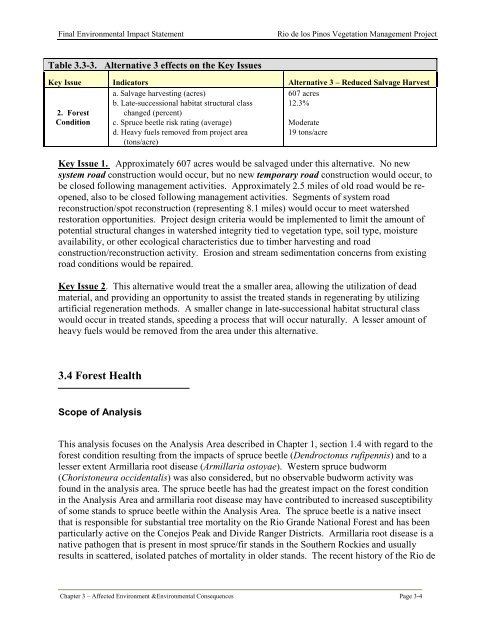Final Environmental Impact Statement Rio de los Pinos Vegetation ...
Final Environmental Impact Statement Rio de los Pinos Vegetation ...
Final Environmental Impact Statement Rio de los Pinos Vegetation ...
Create successful ePaper yourself
Turn your PDF publications into a flip-book with our unique Google optimized e-Paper software.
<strong>Final</strong> <strong>Environmental</strong> <strong>Impact</strong> <strong>Statement</strong> <strong>Rio</strong> <strong>de</strong> <strong>los</strong> <strong>Pinos</strong> <strong>Vegetation</strong> Management Project<br />
Table 3.3-3. Alternative 3 effects on the Key Issues<br />
Key Issue Indicators Alternative 3 – Reduced Salvage Harvest<br />
2. Forest<br />
Condition<br />
a. Salvage harvesting (acres)<br />
b. Late-successional habitat structural class<br />
changed (percent)<br />
c. Spruce beetle risk rating (average)<br />
d. Heavy fuels removed from project area<br />
(tons/acre)<br />
607 acres<br />
12.3%<br />
Mo<strong>de</strong>rate<br />
19 tons/acre<br />
Key Issue 1. Approximately 607 acres would be salvaged un<strong>de</strong>r this alternative. No new<br />
system road construction would occur, but no new temporary road construction would occur, to<br />
be c<strong>los</strong>ed following management activities. Approximately 2.5 miles of old road would be reopened,<br />
also to be c<strong>los</strong>ed following management activities. Segments of system road<br />
reconstruction/spot reconstruction (representing 8.1 miles) would occur to meet watershed<br />
restoration opportunities. Project <strong>de</strong>sign criteria would be implemented to limit the amount of<br />
potential structural changes in watershed integrity tied to vegetation type, soil type, moisture<br />
availability, or other ecological characteristics due to timber harvesting and road<br />
construction/reconstruction activity. Erosion and stream sedimentation concerns from existing<br />
road conditions would be repaired.<br />
Key Issue 2.<br />
This alternative would treat the a smaller area, allowing the utilization of <strong>de</strong>ad<br />
material, and providing an opportunity to assist the treated stands in regenerating by utilizing<br />
artificial regeneration methods. A smaller change in late-successional habitat structural class<br />
would occur in treated stands, speeding a process that will occur naturally. A lesser amount of<br />
heavy fuels would be removed from the area un<strong>de</strong>r this alternative.<br />
3.4 Forest Health<br />
Scope of Analysis<br />
This analysis focuses on the Analysis Area <strong>de</strong>scribed in Chapter 1, section 1.4 with regard to the<br />
forest condition resulting from the impacts of spruce beetle (Dendroctonus rufipennis) and to a<br />
lesser extent Armillaria root disease (Armillaria ostoyae). Western spruce budworm<br />
(Choristoneura occi<strong>de</strong>ntalis) was also consi<strong>de</strong>red, but no observable budworm activity was<br />
found in the analysis area. The spruce beetle has had the greatest impact on the forest condition<br />
in the Analysis Area and armillaria root disease may have contributed to increased susceptibility<br />
of some stands to spruce beetle within the Analysis Area. The spruce beetle is a native insect<br />
that is responsible for substantial tree mortality on the <strong>Rio</strong> Gran<strong>de</strong> National Forest and has been<br />
particularly active on the Conejos Peak and Divi<strong>de</strong> Ranger Districts. Armillaria root disease is a<br />
native pathogen that is present in most spruce/fir stands in the Southern Rockies and usually<br />
results in scattered, isolated patches of mortality in ol<strong>de</strong>r stands. The recent history of the <strong>Rio</strong> <strong>de</strong><br />
Chapter 3 – Affected Environment &<strong>Environmental</strong> Consequences Page 3-4
















